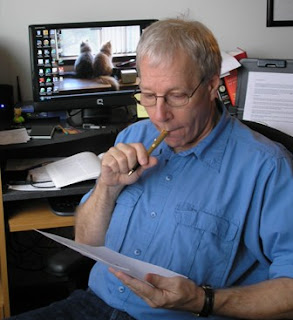by Steve Liskow
In grad school, I had a humanities professor from Germany. His English had only slightly heavier consonants to give away his roots. The reading list was brutal, from The Confessions of St. Augustine to selected essays of Montagne, with Rabelais, Shakespeare, Chaucer (in the original Middle English) and several others along the way. It was a six-week summer course, and we turned in three papers of five, five, and ten pages. There were only ten of us in the seminar, so there was nowhere to hide.
After he returned the first set of essays, the professor scolded us for our "pedestrian" writing styles. "For you, it is your native language, so you do not think about it. It is my fifth language, so I do have to think about it."
After my career as a teacher and another fifteen years or so of conducting writing workshops, I still remember that comment. I grew up in a family of voracious readers and entered kindergarten reading at the fifth-grade level. I also had a solid feel for the rhythm and sound of Midwest American English.
My fourth-grade teacher assigned us to write a poem, and then we read each other's work aloud. I read someone else's poem and changed it as I read it because I could tell that one line had the wrong rhythm. The classmate came up to me after we all read and said, "You changed my poem."
"Yeah," I said. "I made it better."
Hubris at nine years old. Even though I couldn't explain to him why it was better, I knew I was right.
I used to play golf pretty well (nine handicap before I broke my wrist), and I often helped other players fix a flaw in their game so they ended up beating me. I was an adequate actor but a better director because it was like teaching: you prepare the lesson (production) and help the cast convey the play's ideas. I was always a better teacher than a doer, and I think it's because I was basically a kinesthetic learner. I got the feel of the activity into my body and could explain what it felt like to other people. I still do.
How does that relate to the professor's comment above? Well, if you don't have to think about something you can do well, it's difficult to explain how you do it because you've never really observed the "process." I know some very good musicians who can't read music, and they have a hard time explaining how they play something. I'll bet Aaron Judge would have trouble explaining how he hits home runs. He's 6' 7", well-proportioned and athletic, so after all the practice, it's muscle memory rather than consicous thought. The ptch comes in...right...THERE, and he swings.
When I taught composition, I used the textbooks, but occasionally disagreed with some advice because it didn't work for me. I seldom mentioned it unless many students had trouble with the concept, too, and then we'd work it out together. I'll bet those kids know that concept especially well now because they had to work harder at it. One of my warnings in fiction workshops is DON'T rely on Strunk and White's The Elements of Style too much because it's geared specifically to expository writing (essays for college). It's a good start, but it makes everyone's voice/style the same. It won't help with plotting, dialogue, pacing, irony or humor. That means that when I retired from teaching and turned to writing fiction, I knew how to write a sentence and a paragraph, but I knew NOTHING about how to plot a story or control the pace and rhythm.
I had to learn those techniques, and I attended workshops and read dozens of books to master them.
Because I had to work so hard, I can explain them clearly and still be flexible for people whose rhythm and strengths are different from mine. I can write humor, but it's difficult to plan in advance because my sense of humor is built around the rhythms my family instilled when they read to me decades ago. It's instinctual and hard for me to explain. I've only found a couple of books on writing humor, and neither of them helped me.
Dialogue, which also relies on rhythm and a host of other factors, has never been hard for me, either. But it was hard to explain how I did it until I found two books that showed me what I was actually doing and broke it into a process. I rely on those books now, and people have told me my dialogue workshop is one of the best craft workshops they've attended.
I've wanted to play piano most of my life. A few years ago, after trying and failing with several different books, I found a set of DVDs with a booklet that uses graphics to show fingerings and techniques. It speaks to my kinesthetic learning style and I get everything more clearly. I will never be a good, or even adequate keyboard player because I'm starting 65 years too late and I have small hands and minor arthritis. But this approach makes me play the music because the recorded rhythm section carries me along. Rhythm again.
It's the same way I learned to walk and to tie my shoes. Now I do both of those fairly well.
How about you? How do YOU learn?









.jpg)











.jpg)
.jpg)



.jpg)
.jpg)









.jpg)


